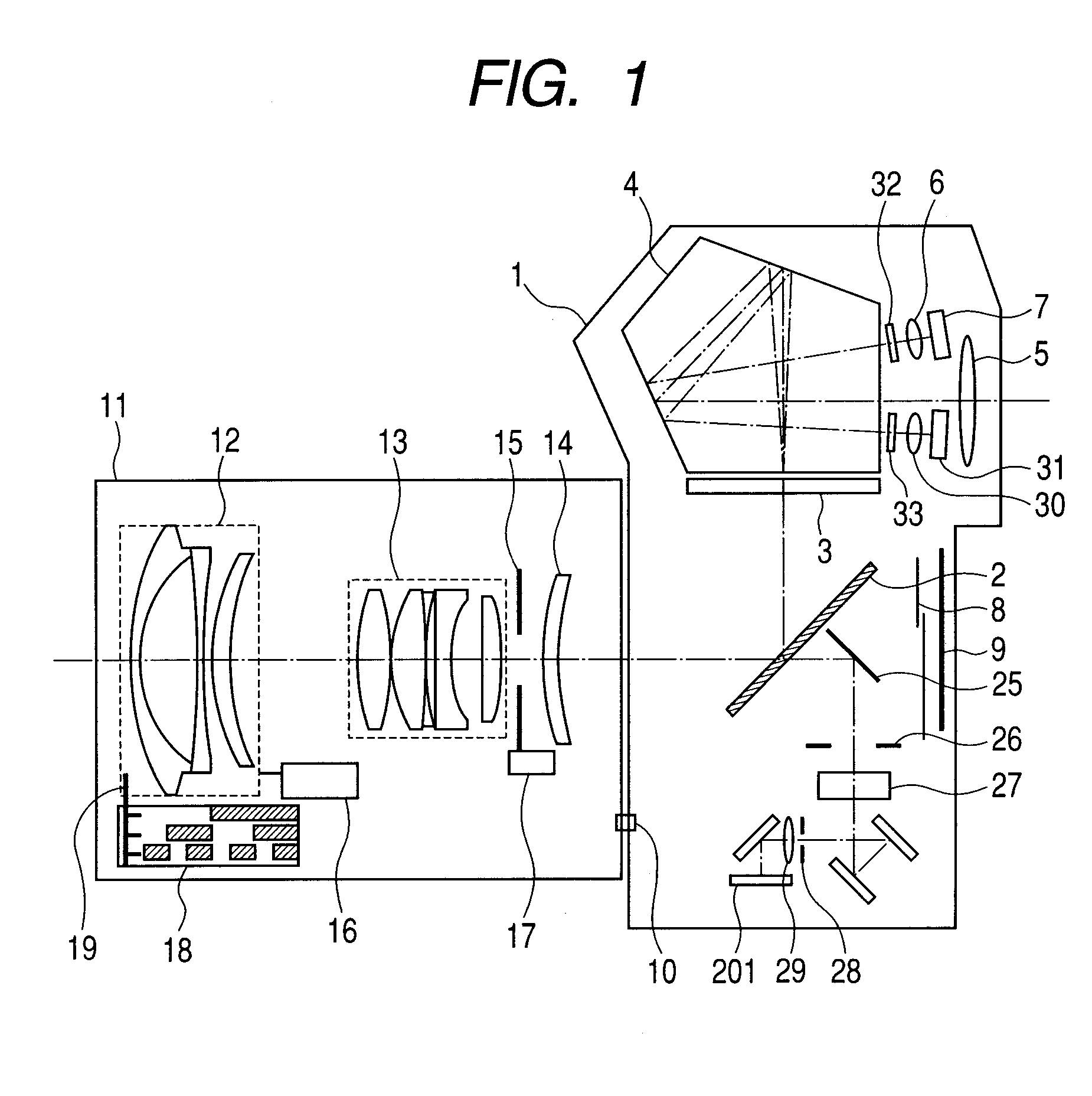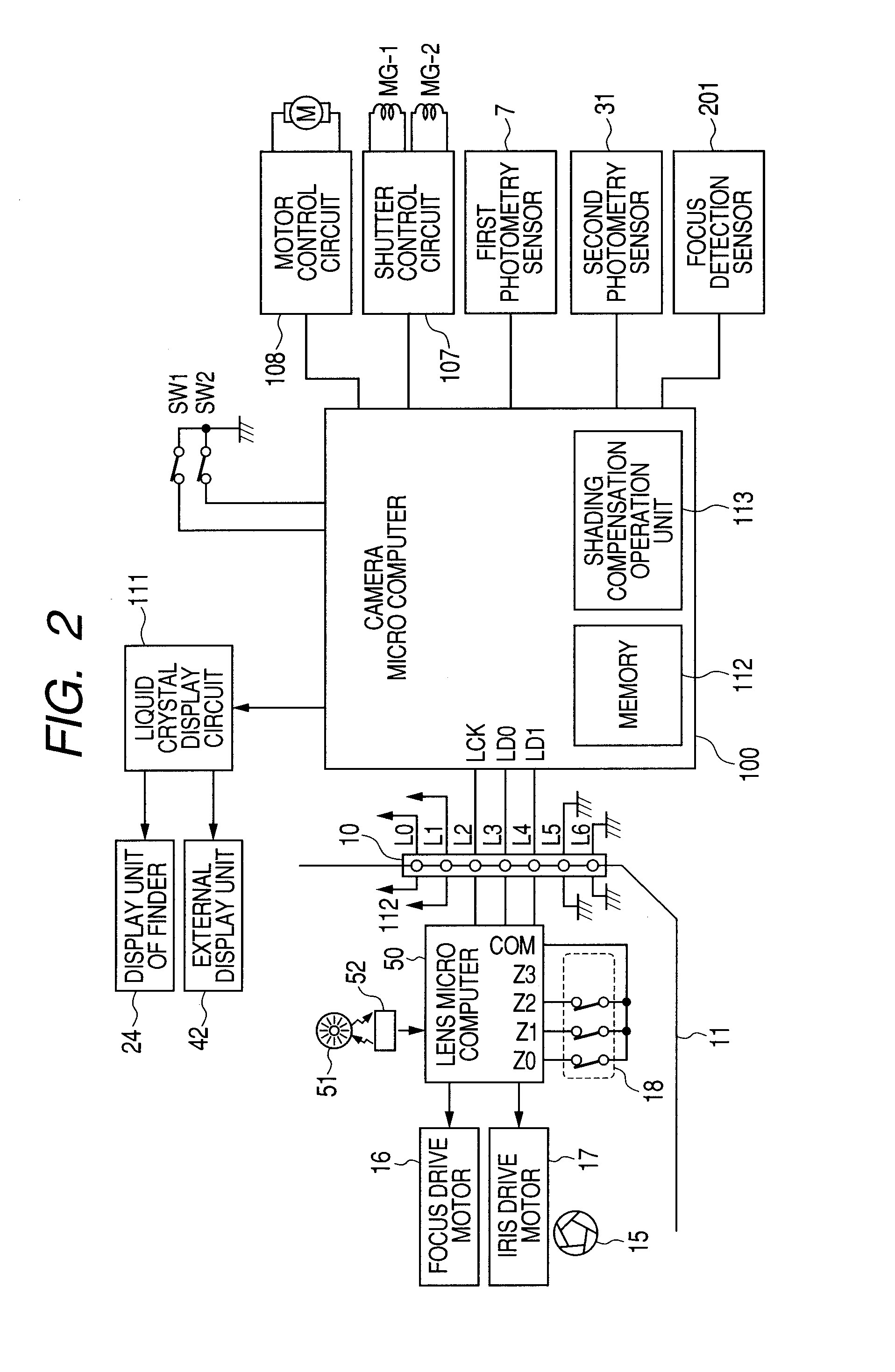Focus detection apparatus
a detection apparatus and focus technology, applied in the direction of mountings, instruments, exposure control, etc., can solve the problems of reducing affecting the detection accuracy of displacement between two images, and the lens aberration becomes relatively large, so as to achieve high focus detection accuracy
- Summary
- Abstract
- Description
- Claims
- Application Information
AI Technical Summary
Benefits of technology
Problems solved by technology
Method used
Image
Examples
first embodiment
[0051]FIG. 1 is a configuration diagram illustrating an auto-focus camera system according to an exemplary embodiment of the present invention and which includes a single lens reflex camera and an interchangeable lens to be mounted on the camera. The diagram primarily illustrates an optical positional relationship of the system.
[0052]In the diagram, a photographing lens 11 is mounted on a front face of a camera main body 1. Optical parts, mechanical parts, an electric circuit, and a film or an imaging element such as a CCD are housed in the camera main body 1 so as to enable photography of a picture or an image. An optical member 2 that is a main mirror (hereinafter referred to as an optical member) is obliquely provided in a photographing optical path in a finder observation state and is withdrawn from the photographing optical path in a photographing state. In addition, the optical member 2 is arranged as a semi-transparent mirror that partially transmits or reflects an incident l...
second embodiment
[0095]In the first embodiment, compensation is performed by selecting, according to a light source determination result, any one of a plurality of shading coefficients stored in advance.
[0096]The second embodiment described below is an exemplary embodiment that performs a compensation operation that differs from the first embodiment.
[0097]FIG. 11 is a flow chart for describing an auto-focusing operation of a camera related to the second embodiment of the present invention. A control flow illustrated in FIG. 11 will be described with reference to FIG. 14 described earlier.
[0098]Operation starts at step S401 when the switch SW1 on the camera main body 1 illustrated in FIG. 2 is pressed. In this case, the camera microcomputer 100 performs an accumulation operation of the line sensors 211a, 211b, 212a, and 212b in the focus detection sensor 201. After accumulation is started, an accumulation status is monitored according to a signal from the focus detection sensor 201. Accumulation is s...
third embodiment
[0109]Cameras according to the first embodiment and the second embodiment perform compensation based on light source detection results and a plurality of shading coefficients stored in advance.
[0110]The third embodiment described below is an exemplary embodiment that performs a compensation operation that differs from the first embodiment and the second embodiment.
[0111]FIG. 12 is a flow chart for describing an auto-focusing operation of a camera related to the third embodiment of the present invention. A control flow illustrated in FIG. 12 will be described with reference to FIG. 14 described earlier.
[0112]Operation starts at step S501 when the switch SW1 on the camera main body 1 illustrated in FIG. 2 is pressed. In this case, the camera microcomputer 100 performs an accumulation operation of the line sensors 211a, 211b, 212a, and 212b in the focus detection sensor 201. After accumulation is started, an accumulation status is monitored according to a signal from the focus detectio...
PUM
 Login to View More
Login to View More Abstract
Description
Claims
Application Information
 Login to View More
Login to View More - R&D
- Intellectual Property
- Life Sciences
- Materials
- Tech Scout
- Unparalleled Data Quality
- Higher Quality Content
- 60% Fewer Hallucinations
Browse by: Latest US Patents, China's latest patents, Technical Efficacy Thesaurus, Application Domain, Technology Topic, Popular Technical Reports.
© 2025 PatSnap. All rights reserved.Legal|Privacy policy|Modern Slavery Act Transparency Statement|Sitemap|About US| Contact US: help@patsnap.com



